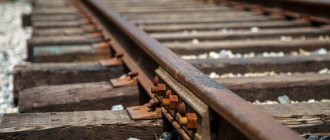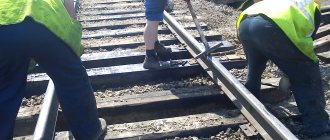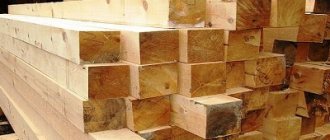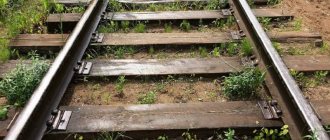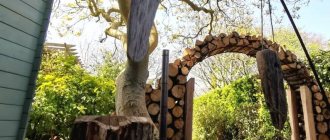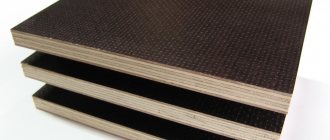Sleepers are used when laying railway tracks as a support for rails. Crushed stone or gravel is poured and leveled onto the earthen platform - the so-called “ballast layer” (ballast), on which sleepers are laid.
Ballast allows you to evenly distribute the load received from the sleepers, and prevents them from moving sideways or longitudinally when a train passes. The thickness of such a layer is at least 0.3 meters. Recently, crushed stone is used less frequently, replacing it with concrete.
In turn, the sleepers take on the load from the rails and maintain their stability, preventing them from shifting under the pressure of moving or braking trains. Sleepers keep the track gauge constant. The rails are attached to the sleepers with special screws or “crutches”. Sleepers and rails act as a kind of shock absorber, preventing the ground from subsiding under the weight of a multi-ton train.
Sleepers can be made of wood, reinforced concrete, or composite. Several years ago, up to 90% of the sleepers on the tracks were wooden. Today, only slightly more than half of all sleepers laid are made of wood. When constructing new railways and repairing old ones, wooden sleepers are replaced with reinforced concrete ones.
Pros and cons of wooden sleepers
Despite the fact that the number of composite and reinforced concrete sleepers used is constantly increasing, wooden sleepers will not leave the market for a long time due to their undeniable advantages.
Advantages of wooden sleepers:
- high elasticity;
- ease and simplicity of production and processing (the production of wooden sleepers is cheaper than the production of reinforced concrete ones);
- allow you to adjust the track width in curves with a small radius;
- a simple way to attach rails to them;
- strong adhesion to the ballast layer;
- resistance to mechanical shocks and force loads;
- resistance to temperature changes;
- light weight (three times lighter than reinforced concrete);
- a railway track with wooden sleepers has less rigidity than with reinforced concrete ones;
- low electrical conductivity (accordingly, better electrical insulation of rails).
Pine wood is best suited for the production of sleepers; spruce, fir, cedar, larch and birch are also used.
First, the wood is cut and the timber is obtained in the correct shape. Then sleepers are made from it, according to the dimensions approved by GOST. After mechanical processing, the manufacturer performs an antiseptic treatment and places his mark on one of the ends of the sleeper.
Sleepers are impregnated with coal oils, creosote, and antiseptics.
During operation, sleepers are exposed to the destructive effects of precipitation, dynamic loads, and temperature changes. As a result, defects appear, such as:
- Longitudinal cracking and splitting at the end ends. In this case, the internal parts not treated with protective substances are opened. As a result, the sleeper quickly becomes unusable;
- Deformation and rotting under the fastenings of the linings.
In addition to the defects that arise, wooden sleepers have a number of disadvantages:
- short service life - 15 years (reinforced concrete ones last from 30 to 50 years);
- the high price of timber from which sleepers are made;
- low wear resistance of wood;
- recycling problem.
Definition
Reinforced concrete sleepers have the form of a rail support, the manufacture of which will require beams with varying sizes and cross-sectional shapes. Concrete rail supports are reinforced with steel wire, the diameter of which depends on the modification. When working with reinforced concrete sleepers, the following requirements are imposed on their production technology:
- preparing concrete mortar requires a uniform consistency;
- for the necessary transmission of stress, the material must have appropriate strength;
- When manufacturing products, they adhere to the exact dimensions and shapes that are important for reinforced concrete sleepers at the junction with the rails.
Return to contents
Application
Wooden sleepers can be used in any laying areas: link tracks with wider gauges, narrow gauge tracks, curves with a small radius (up to 300 meters), on swampy soils, in permafrost zones, on unstable soils, on tracks with high freight traffic.
The use of wooden sleepers is more effective than reinforced concrete sleepers on continuous continuous tracks that are intensive in cargo transportation.
Plastic
This material is still rarely used for the manufacture of sleepers, but production is gradually increasing. The leader here is the USA, producing up to 15 million sleepers per year (their approximate cost is 500 million dollars). For the production of plastic sleepers, composite materials are used, which have proven themselves in the construction of bridges (cladding). The same composite composition is widely used for the manufacture of sea piles and berths.
The production is carried out by several companies that have managed to agree on sleeper standards and conduct their tests. The weight of the products is 200-280 pounds (production technology and product length play a role here).
Parameters of wooden sleepers
The GOST 78-2004 standard, in force since 2006, is used in the countries of the customs union and clearly regulates the parameters and class of wooden sleepers. There are 3 classes in total, the first is the highest. Dimensions are set depending on the class.
So, for class 1, the thickness is set to 1.8 m, the height of the sides (sawed) is 1.5 m, the width of the side at the top is 1.8 m and 2.1 m, at the bottom - 2.5 m. For sleepers of class 3: thickness 1, 5 m, height of the sides (sawed) 1.05 m, width of the upper side 1.4 m and 1.9 m, bottom - 2.5 m. The total length of the three classes is 275 cm. For these parameters, wood moisture content of up to 22% is required . If the humidity level is higher than normal, allowances for drying are required (GOST 6782.1-75 and GOST 6782.2-75).
A prerequisite is antiseptic impregnation of the sleeper before laying and marking on the end.
Size, length
Standard length 275 cm (+/- 2 cm). For tracks with high freight traffic, the length can be increased to 280 cm. For tracks with different gauges, the length can be 3 m.
Weight
The weight of coniferous wood sleepers ranges from 80 to 85 kg.
Where are they used?
Nowadays, everyone wants to save money - used sleepers provide this opportunity when building your own home.
Reinforced concrete sleepers are used in the construction of foundations and railway tracks. Due to different natural operating conditions and varied mechanical loads on products, increased requirements are adhered to in the manufacture of reinforced concrete supports. This will increase the service life, which under favorable conditions of use will reach sixty years. Posts made using prestressed concrete outshine common wood posts everywhere due to their strength, durability and speed of installation.
Return to contents
Types of Wood Sleepers
Sleepers are divided into three types depending on the paths where they will be laid:
- For main (main tracks) (classes 1 and 2) and tracks with high freight traffic.
- For main tracks (classes 3 and 4) and marshalling tracks with high traffic intensity.
- For tracks of class 5, shunting, with low traffic intensity.
According to the cross section (its shape), sleepers are divided into:
- Edged - 4 sides are sawn - laid in the main tracks.
- Semi-edged - 3 sides are sawed through, the remaining two may not be sawed completely - used in tracks at stations and non-public tracks.
- Unedged - 2 opposite sides are sawn through - for non-public routes with low freight traffic.
It is permissible to use previously used sleepers removed during repair or construction work. Such sleepers are divided into categories:
- Category 1 – sleepers with wear up to 5 mm, without splitting through, without rot and with fastening hole sizes up to 24 mm. Allowed to be used on tracks of 1, 2 and 3 classes, as well as sorting.
- Category 2 - wear from 30 to 50 mm, cracks, end-to-end splits, mounting holes up to 4 cm are allowed. In addition, the length is allowed to be reduced to 250 cm after removing the rotten part of the end ends. Can be used on routes of 3 and 4 classes.
- Category 3 – this includes sleepers that are not included in the first two categories according to their characteristics, as well as composite sleepers that have the same type of material. Can only be used on class 5 tracks.
Production technology
Regardless of the area of use, reinforced concrete supports are made with the same strength and performance properties. There are four types of support manufacturing technology:
- Carousel type followed by mold removal. It consists of preparing the mixture and pouring it into molds, where it is further compacted. Remove the supports from the container after the solution has completely hardened and reached its maximum strength. For manufacturing, cassette structures are used, which accommodate six supports. To achieve the required adhesion and provide prestress, reinforcement is used, with the help of which the stress is transferred to the surface of the concrete. Upon completion of the product, the mold is removed and started for the next production.
- Linear. This type of manufacturing a reinforced concrete support involves a linear technology, which requires a conveyor on which the forms are placed in a certain sequence. The length of the installed forms reaches one hundred meters. The sides of the container are covered with specially designed devices, which are also capable of transmitting voltage to the reinforcement. As the mortar sets, stress is transferred to the surface of the concrete.
- Dismantling of forms with further stress. This type of manufacturing of reinforced concrete supports requires the installation of templates, with the help of which the location of steel reinforcement is determined. The containers are filled with concrete mortar and compacted. While the solution is setting, the pins are immersed in it. After some time, the mold and template are removed.
- Dismantling forms with prestressing is the same technology as when dismantling forms with further tension, only instead of pins, frames are used that provide a tension force in the product.
Return to contents
Technical requirements for wooden sleepers
Sleepers must fully comply with GOST requirements. It should be added that the uncut sides of the sleepers must be completely cleared of bark. Knots are cut flush with the surface.
The manufacturer must treat the sleepers with oil-based protective agents. For storage, sleepers must be stacked in dry warehouses.
The quality of used sleepers must be regularly monitored. For this purpose, detours are provided. If any defects are found, they are immediately eliminated.
Sleeper means "support" in Dutch. Sleepers appeared in Russia in 1834, but to this day their era has not yet ended.
